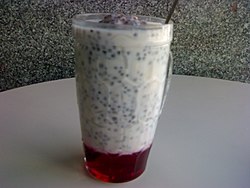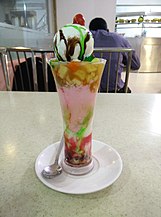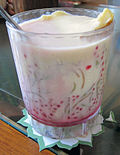 Falooda with kulfi, rose syrup, and basil seeds (sabja seeds) | |
| Type | Drink |
|---|---|
| Course | Beverage |
| Region or state | South Asia |
| Serving temperature | Cold |
| Main ingredients | Milk, rose syrup, vermicelli, sweet basil |
| Similar dishes | Bandung, nam maenglak, alouda, Bombay crush |
A falooda is a Mughlai cold dessert made with vermicelli. [1] [2] It has origins in the Persian dish faloodeh , variants of which are found across West, Central, South and Southeast Asia. [3] Traditionally it is made by mixing rose syrup, vermicelli, and sweet basil seeds with milk, often served with ice cream. [4] The vermicelli used for preparing falooda is made from wheat, [5] arrowroot, cornstarch, or sago. [6]




